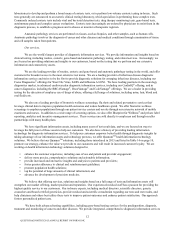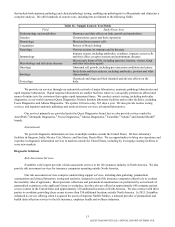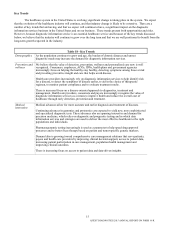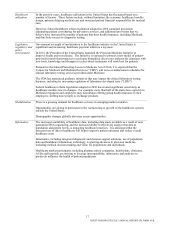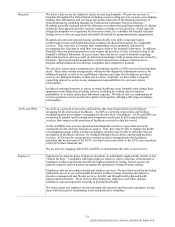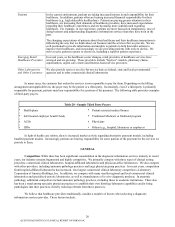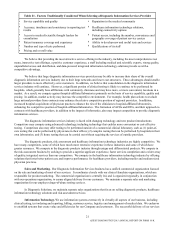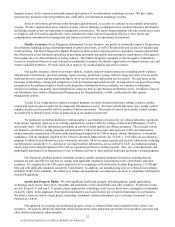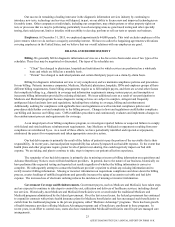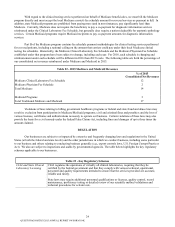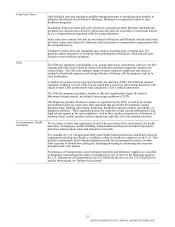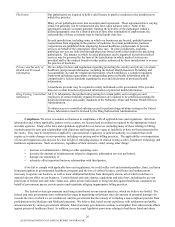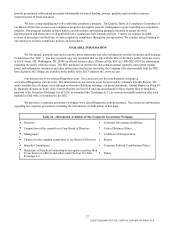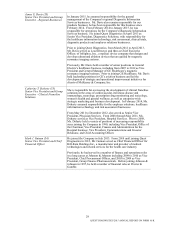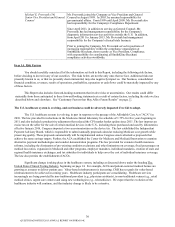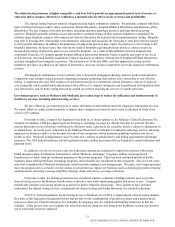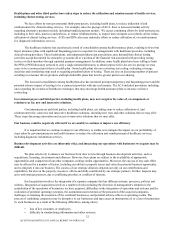Quest Diagnostics 2015 Annual Report Download - page 26
Download and view the complete annual report
Please find page 26 of the 2015 Quest Diagnostics annual report below. You can navigate through the pages in the report by either clicking on the pages listed below, or by using the keyword search tool below to find specific information within the annual report.22
depends, in part, on the continued and uninterrupted performance of our information technology systems. We have taken
precautionary measures to prevent problems that could affect our information technology systems.
Some of our historic growth has come through acquisitions and, as a result, we continue to use multiple information
systems. We have implemented some common systems, and are planning to implement more common laboratory information
and billing systems across our operations to standardize our processes. We expect implementation will take several more years
to complete, and will result in significantly more centralized systems, improved operating efficiency, more timely and
comprehensive information for management and enhanced control over our operational environment.
Quality Assurance. In our Diagnostic Information Services business, our goal is to continually improve the processes
for collection, handling, storage and transportation of patient specimens, as well as the precision and accuracy of analysis and
result reporting. The Quest Diagnostics Quality Program includes policies and procedures to document, measure and monitor
the effectiveness of our laboratory operations in providing and improving quality and meeting the requirements of the agencies
that regulate the U.S. clinical laboratory testing industry. The Quality Program is designed so that the quality of laboratory
services is monitored objectively and evaluated systematically to proactively identify opportunities to improve patient care and
resolve identified problems. We track, and seek to improve on, medical quality and service metrics.
Our quality assurance efforts focus on pre-analytic, analytic and post-analytic processes, including positive patient
identification of specimens, specimen tracking, report accuracy, proficiency testing, reference range relevance, process audits,
statistical process control and personnel training for all of our laboratories and patient service centers. We also focus on the
licensing, credentialing, training and competence of our professional and technical staff. To help achieve our goal of becoming
recognized as the undisputed quality leader in the diagnostics information services industry, we continue to implement
initiatives to enhance our quality and standardization, using our best-in-class business performance tools. In addition, some of
our laboratories have achieved International Organization for Standardization, or ISO, certification for their quality
management systems.
As part of our comprehensive quality assurance program, we utilize internal proficiency testing, extensive quality
control and rigorous process audits for our diagnostic information services. For most clinical laboratory tests, quality control
samples are processed in parallel with the analysis of patient specimens. The results of tests on these quality control samples
are monitored to identify trends, biases or imprecision in our analytical processes.
We participate in external proficiency testing and have accreditation or licenses for our clinical laboratory operations
from various regulatory agencies or accrediting organizations, such as CMS, the College of American Pathologists (“CAP”)
and certain states. All of our laboratories participate in various external quality surveillance programs. They include, but are
not limited to, proficiency testing programs administered by CAP, as well as some state agencies. CAP is an independent,
nongovernmental organization of board-certified pathologists approved by CMS to inspect clinical laboratories to determine
compliance with the standards required by the Clinical Laboratory Improvement Act ("CLIA"). CAP offers an accreditation
program to which clinical laboratories may voluntarily subscribe. All of our major regional and esoteric laboratories, including
our laboratories outside the U.S., and most of our rapid response laboratories, are accredited by CAP. Accreditation includes
on-site inspections and participation in the CAP (or equivalent) proficiency testing program. Also, our cytotechnologists and
pathologists participate in an internal peer-review evaluation and one or more external individual proficiency testing programs.
Our diagnostic products business maintains extensive quality assurance programs focused on ensuring that our
products are safe and effective and that we comply with applicable regulatory requirements in the United States and other
countries. It is regulated by the FDA and is required to be in compliance with the Quality Systems Regulations, 21 CFR part
820, and with applicable standards outside the United States. In addition, our manufacturing sites are certified in accordance
with ISO 13485: 2003 standards. We endeavor to design and manufacture our diagnostics products in compliance with Quality
Systems Regulations.
Intellectual Property Rights. We own significant intellectual property, including patents, patent applications,
technology, trade secrets, know-how, copyrights and trademarks in the United States and other countries. From time to time,
we also license U.S. and non-U.S. patents, patent applications, technology, trade secrets, know-how, copyrights or trademarks
owned by others. In the aggregate, these intellectual property assets and licenses are of material importance to our business.
We believe, however, that no single patent, technology, trademark, intellectual property asset or license is material to our
business as a whole.
Our approach is to manage our intellectual property assets, to safeguard them and to maximize their value to our
enterprise. We actively defend our important intellectual property assets and pursue protection of our products, processes and
other intellectual property where possible.
QUEST DIAGNOSTICS 2015 ANNUAL REPORT ON FORM 10-K


